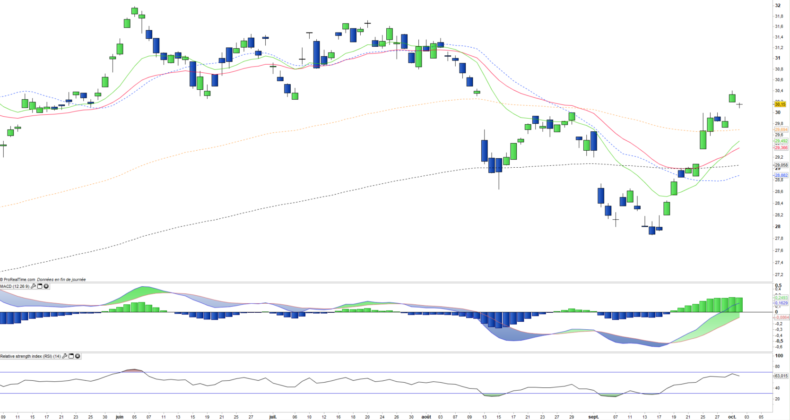iShares MSCI Saudi Arabia - KSA - 03/10/2018
Short Term strategy: Positive (90%) / Trend +
Long Term strategy: Positive (95%) / Trend +
Characteristics of the ETF
The KSA ETF (iShares) created in 09/2015 is listed in USD on the NYSE and replicates the MSCI Saudi Arabia Index IMI 25/50 Index which is made up of the top 72 Saudi stocks, composed for 70% of mining stocks and banks . KSA offers a "pure" exposure to Saudi Arabia but this index also carries a significant risk related to the evolution of the local currency, the Saudi Riyal.
The fees of this ETF are 0.74% for AUM of $ 242M. The replication method is direct (physical) and there is a policy of semi-annual distribution of dividends.
Alternative ETFs: N / A
Latest developments
After a modest increase of 3.6% in 2016, KSA is now up 15.9% in 2018, which is a significant outperformance compared to other global equity markets, while the MSCI World is up 3.3 % since the beginning of the year. This very good relative performance is explained by the rise in oil prices which stand at 2-year highs, which gives the Kingdom more budget flexibility, especially since the Aramco listing was postponed “sine die”, because of the lack of interest of the investors related to the significant outflow on the company which ensures 60% of the state operating budget.
The rise in oil is linked to the US embargo on Iranian oil, strong global growth and the "gap" of investment that will lead to a more limited supply in the next two years which cannot be filled entirely by shale oil.
Index & components
The MSCI Saudi Arabia index is quite diversified with 72 stocks and a high weighting of mining (33%) and financial (37.8%).
The big missing part of this index is the state-controlled energy sector, whose importance is such that it is reflected throughout the Saudi market.
The country has the largest oil reserves in the world and is also the largest producer and exporter of oil in the world, but soon overtaken by the United States through shale oil. Oil accounts for more than 90% of the country's exports and nearly 80% of government revenue.
The share of the non-oil industrial sector is growing as a result of the Saudi state's investment in the diversification of the economy. Finally, services account for more than 50% of GDP and employ a large majority of the population. This sector is mainly dominated by tourism, financial and banking services, as well as insurance. Tourism generates very large revenues (almost 4 million tourists a year), exclusively thanks to the pilgrimage to Mecca. But the fall in oil prices has led to a slowdown in growth recently.
After reaching 3.5% of GDP in 2015, Saudi economic growth fell sharply in 2016, reaching only 1.2% of GDP and a gradual recovery was formed in 2017, supported by the rise in oil prices. Saudi Arabia's GDP reaches around $ 655bn in 2017, the public debt (15% GDP) has increased significantly but remains sustainable because of the large Saudi reserves. With the erosion of the latter, the authorities launched for the first time a loan of 17 billion USD in the international financial markets.
The government presented its Saudi Vision 2030 development plan and announced the launch of a privatization program, including the oil monopoly Aramco which has been delayed indefinitely. The National Transformation Program 2020 was also launched with the objectives of increasing non-oil revenue, creating jobs and increasing women's participation in the labor market.
Weekly data
The weekly chart shows a positive medium-term trend that is strengthening with a new upward momentum, which should allow the index to quickly post new highs. This brutal bullish departure has allowed prices to return above moving averages that narrowly avoid a bearish cross and should also allow the MACD to turn upward soon. The acceleration should continue after the opening of a bullish gap.
Daily data
On the daily chart, we can observe a very impulsive rebound that allows the index to turn up in the short term, with the crossing of all moving averages and the upward crossing of MME13 and 26. All oscillators have returned to the upside and the short-term objective of the index is to reach the level of 32 € which corresponds to the previous peak reached during the summer.
ETF Objective
KAS is an ETF listed in USD, which seeks to replicate the MSCI Saudi Arabia IMI 25/50 Index
Characteristics
| Inception date | 16/09/2015 |
| Expense ratio | 0,74% |
| Issuer | iShares |
| Benchmark | MSCI Saudi Arabia IMI 25/50 Index |
| Ticker | KSA |
| ISIN | US46434V4234 |
| UCITS | No |
| Currency | $ |
| Exchange | NYSE Arca |
| Assets Under Management | 240 M$ |
| Dividend | Distribution |
| Number of Holdings | 72 |
| Risk | 4/5 |
Country breakdown
| Saudi Arabia | 100% |
Sector breakdown
| Financials | 42% |
| Materials | 34% |
| Communication | 7% |
| Consumer staples | 5% |
| Consumer discretionary | 3% |
| Utilities | 3% |
| Others | 6% |
Top Ten Holdings
| Saudi Basic Industries | 16% |
| Al Rajhi Bank | 12% |
| National Commercial Bank | 10% |
| Saudi Telecom | 5% |
| Samba Financial Group | 5% |
| Saudi Arabian Mining | 4% |
| Riyad Bank | 3% |
| Alinma Bank | 3% |
| Almarai Co. | 3% |
| Yanbu National Petrochemicals | 3% |


